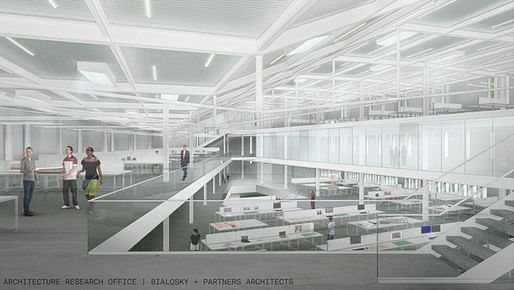

From simple and functional to splendidly provocative, four proposals vying to become reality as Kent State University's new College of Architecture and Environmental Design were presented to the public Thursday.
The university hosted the four partnerships competing to design the $40 million building by providing a forum so the architects could pitch their ideas for "solving the problem," as one presenter put it.
— kent.patch.com
The four teams and their proposals are:




Bialosky + Partners Architects, with offices in Cleveland and New York, in association with Architecture Research Office of New York, proposed a building with a skin of light brown precast concrete panels rising from a one-story base of tan brick. The building emphasized a sculptural look and featured vertical windows. Architect Stephen Cassell of ARO said the building would qualify for a platinum rating – the highest available – under the LEED system of the U.S. Green Building Council, which stands for Leadership in Energy and Environmental Design, but ran out of time before he could explain the details.





Richard L. Bowen + Associates Inc. of Cleveland in association with Weiss/Manfredi of New York, proposed a glassy structure they called “Design Loft.” The project emphasized flexible interior spaces organized around a skeletal structural system and interior ramps and staircases that knitted the interior together.






The Collaborative Inc. of Toledo, Ohio, in association with the Miller Hull Partnership of Seattle, proposed a design in which architecture studios for students would be installed in a series of north-south rectangular “tubes” set atop an east-west rectangular base that would parallel the KSU campus Esplanade. The studio zones would be connected to one another with interior pathways that would invite students inside to take a shortcut through the building during cold weather – and simultaneously check out what the architecture students were up to.





Cleveland-based Westlake Reed Leskosky, the only local firm to enter the competition without a high-powered design partner from outside the region, proposed a building with elegantly detailed facades and powerful geometric shapes that echoed the firm’s recent Bertram and Judith Kohl Building at Oberlin College. The design aimed to make use of natural ventilation and daylight to save on energy costs.
2 Comments
Its surprising how conventional these designs are. Not saying that's a bad thing (maybe architecture school buildings should be less "starchitecty), but its still unexpected.
Reminds me of all the brutalist buildings that are at risk or have been torn down across america.........
Block this user
Are you sure you want to block this user and hide all related comments throughout the site?
Archinect
This is your first comment on Archinect. Your comment will be visible once approved.